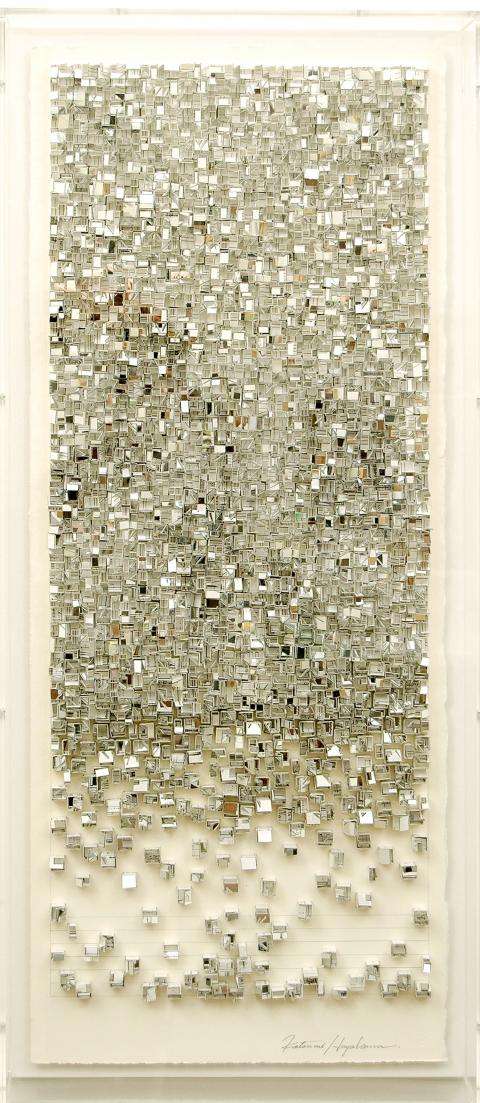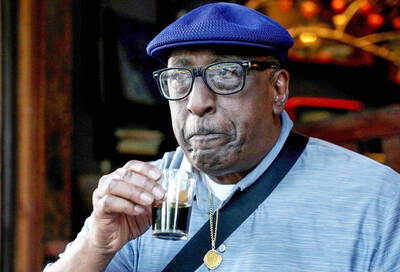Japanese artist Katsumi Hayakawa still recalls his reaction to Powers of Ten, a documentary he watched in junior high school that depicts, by positive and negative factors of 10, microcosmic and macrocosmic views of the known universe. The broad range of visual perspectives was, for Hayakawa, a revelation.
“I was shocked by what I saw,” he told the Taipei Times on Saturday. “You see the Earth, then the solar system, then the galaxy and then the universe and then it returns to the Earth and the camera shows [human] skin and then goes inside the body and becomes microscopic. It shows that what is outside and inside the human body are [interconnected].”
The documentary, written and directed by Charles and Ray Eames, who both made important contributions to contemporary architecture and design, “seems to contain the same ideas found in Buddhism,” Hayakawa said, referring to the notion that all phenomena are interconnected.

Photo courtesy of Nou Gallery
Hayakawa referenced the documentary to explain the ideas found in Urban Landscape, a series of 15 paper sculptures encased behind polymer casings and hung like paintings that are currently on view at Nou Gallery (新畫廊). Thankfully, knowledge of the universe or Buddhism isn’t required to enjoy them. The flat and built-up works ruminate on the visual similarities between electronic circuitry and urban environments, or the relation between simulated reality and concrete space.
Hayakawa, 40, is more commonly known for his geometric paintings in a style that could be called “virtual abstraction.” Tiny circles and squares in primary colors are linked by dark horizontal and vertical lines that make the works look like the inside of an integrated circuit. Each canvas contains several layers of paint that are etched to create the illusion of depth.
But Hayakawa was dissatisfied with the medium’s inherent flatness, and so he decided two years ago to shift to sculpture — a move, he said, that was initially fraught with difficulty because it received little support from galleries.

Photo courtesy of Nou Gallery
“They told me that [paper] is hard to preserve and therefore difficult to sell,” he says.
Three formative sculptures made last year hang at the back of the gallery, and this reviewer suggests viewers look at them before moving to the front to see the 12 works made this year. Two of these sculptures, Hakamono — Box 1 and Composition 3, are of particular interest because they serve as a kind of blueprint for the rest of the sculptures on display.
Hayakawa’s non-representational sculptures are built up using cubes or squares that he pastes onto watercolor paper. Hakamono — Box 1 (2010) is a single layer of these variously sized cubes pasted onto paper. The simple design and neatly arranged rows give the cubes and squares the appearance of capsule hotels or coffin-sized apartments, both features of Japan’s densely populated urban centers.
Whereas Hakamono — Box 1 uses cubes as its primary design element, the larger Composition 3 (2010) presents several vertiginous layers of square frames that grow more and more complex. It looks like scaffolding that has collapsed and then been randomly pieced back together. The arbitrary, almost erratic, profusion of shapes jutting out from the surface forces the eyes to continually search in vain for a place to fix on — perhaps a metaphor for our information-overloaded times.
Hayakawa’s 2011 sculptures are refined versions of his earlier creations. Traffic is similar to Composition 3, though the large blank spaces at the bottom of the canvas, revealing traditional Japanese paper, offer some visual respite. Traffic — Blue Lines does the same, and gives us a sense of Hayakawa’s influences with its Mondrian-inspired visual language and high-tech building design, which reminded me of France’s Pompidou Center.
Many of the other 2011 works appear to be trial models for as yet uncreated works. Reflection 3 is an assemblage of tiny, mirrored cubes that focus on line and reflection and the blurring of the two. Transcolor 2, with its colored lines discernable through a matrix of rectangles, experiments with holography, depth perception and the illusion of space.
The fact that Hayakawa has focused his artistic attention on sculpture for only a few years lends many of these works the appearance of sculptural experiments, which translates, for this reviewer, into incomplete artistic concepts. Still, Hayakawa is on to something here, and the fact that I can’t quite put my finger on exactly what shouldn’t discourage people from visiting the gallery to view his extremely original artwork.
Hayakawa has also designed a public art project with Nou Gallery, to be held throughout the exhibit period. Dubbed Create Dream City With Katsumi, visitors are invited to create their own “dream home” using Hayakawa’s trademark cubes and cutout squares. Each participant is given a square piece of watercolor paper on which they are directed to erect their sculpture. The works are then affixed to a large canvas, which hangs at the back of the gallery space.

On April 26, The Lancet published a letter from two doctors at Taichung-based China Medical University Hospital (CMUH) warning that “Taiwan’s Health Care System is on the Brink of Collapse.” The authors said that “Years of policy inaction and mismanagement of resources have led to the National Health Insurance system operating under unsustainable conditions.” The pushback was immediate. Errors in the paper were quickly identified and publicized, to discredit the authors (the hospital apologized). CNA reported that CMUH said the letter described Taiwan in 2021 as having 62 nurses per 10,000 people, when the correct number was 78 nurses per 10,000

As we live longer, our risk of cognitive impairment is increasing. How can we delay the onset of symptoms? Do we have to give up every indulgence or can small changes make a difference? We asked neurologists for tips on how to keep our brains healthy for life. TAKE CARE OF YOUR HEALTH “All of the sensible things that apply to bodily health apply to brain health,” says Suzanne O’Sullivan, a consultant in neurology at the National Hospital for Neurology and Neurosurgery in London, and the author of The Age of Diagnosis. “When you’re 20, you can get away with absolute

May 5 to May 11 What started out as friction between Taiwanese students at Taichung First High School and a Japanese head cook escalated dramatically over the first two weeks of May 1927. It began on April 30 when the cook’s wife knew that lotus starch used in that night’s dinner had rat feces in it, but failed to inform staff until the meal was already prepared. The students believed that her silence was intentional, and filed a complaint. The school’s Japanese administrators sided with the cook’s family, dismissing the students as troublemakers and clamping down on their freedoms — with

As Donald Trump’s executive order in March led to the shuttering of Voice of America (VOA) — the global broadcaster whose roots date back to the fight against Nazi propaganda — he quickly attracted support from figures not used to aligning themselves with any US administration. Trump had ordered the US Agency for Global Media, the federal agency that funds VOA and other groups promoting independent journalism overseas, to be “eliminated to the maximum extent consistent with applicable law.” The decision suddenly halted programming in 49 languages to more than 425 million people. In Moscow, Margarita Simonyan, the hardline editor-in-chief of the